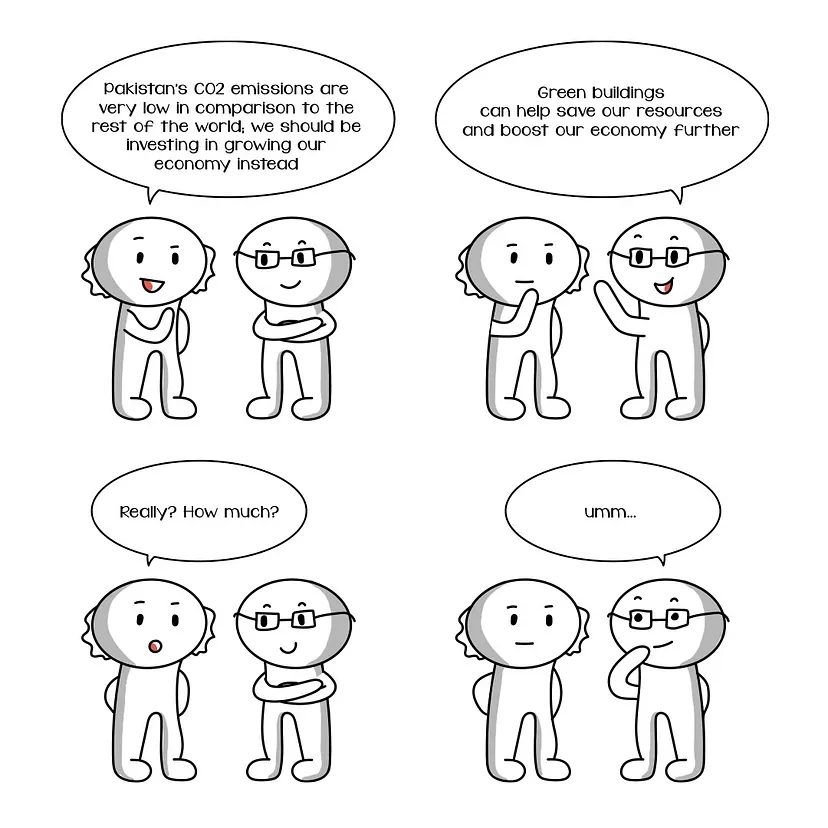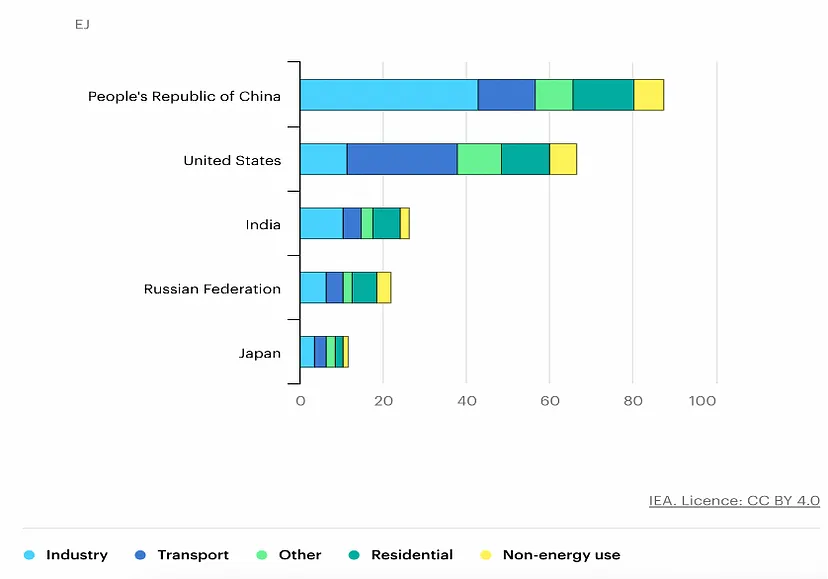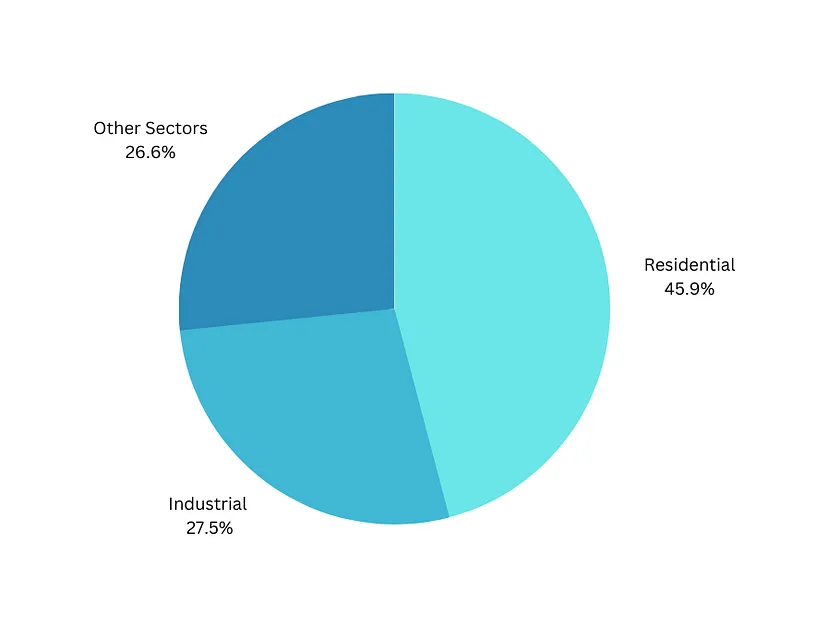Green buildings are a “nice to have” or perhaps can help reduce Pakistan’s CO2 emissions and energy needs to some degree. The article aims to quantify that “degree” and answer if there is a business case for having green buildings in Pakistan. If so, what would that mean for the end user, the property developers, and the entire country? With the data available so far, there is no quantifiable answer to the monetary benefit of such policies. Hence, what follows is a dip in the water to understand what a business case for green buildings could look like from a policy-making perspective.

Local Context
Pakistan currently consumes 92.33 billion kWh of electricity annually[1], 45.9% of which is used by the residential sector[2]. The proportion in Pakistan is comparatively much higher than other countries where the residential sector makes up 20–30% of the total energy consumption (see Figure 1).


While Pakistan’s residential sector guzzles most of its energy, the Energy Building Code 2011[4] prepared by the National Energy Efficiency and Conservation Authority (NEECA) remains unimplemented and is only applicable to buildings that have a total connected load of at least 100 kilowatts while having a conditioned area of at least 900m2. This disqualifies all single-unit homes and most apartment blocks.
The energy efficiency and conservation policies in Pakistan mainly focus on commercial buildings. Single family or multifamily houses are not the focus of existing policy.
The current policies and growing presence of Pakistan Green Building Council have been able to create a push in the nascent green building sector particularly in the commercial sectors. As a result since 2014, the green building footprint has grown from 5000 sq.ft. to 7 million sq.ft.[5] in the form of 21 LEED certified projects in the country all belonging to industrial or retail sectors, which respectively make up 27.5% and 8.4% of the total energy consumption[6] — much less than that of the residential sector.
Meanwhile, some emerging economies are making progress in their transition towards green. For example, in Colombia, 8% of all new buildings have been certified with EDGE[7], which is a green building certification tool developed by the International Finance Corporation (IFC), to measure and prove the impact of building green. The push towards green buildings in Colombia has been made possible due to government and banking incentives. On the contrary, Vietnam has also experienced similar 8% growth, despite not having any incentives in place. Developers in Vietnam are beginning to recognize the value of green buildings and their potential to differentiate their products.
According to a recent study by World Green Building Council, “building and construction sectors are responsible for almost 40% of global greenhouse gas emissions. And by 2060, the floor area of buildings will be double, adding more than 230 billion m2 in new building construction means adding more emissions to the atmosphere.”
Pakistan’s Growing Residential Needs
Although Pakistan can be completely self-sufficient with its domestic energy production capacity of 110 billion kWh[8], what lies ahead can be a burden to its economy… According to the National Report for Habitat III by the Ministry of Climate Change in 2015, the annual incremental demand for housing is estimated at 600,000 while only 370,000 units are being built, that too mostly in urban areas[9].
Pakistan is expected to be one of nine countries that will house more than half of the world’s population by 2050[10]. In line with this estimate, over the next three decades, Pakistan’s population of ~230 million in May 2022 is expected to almost double in size to ~403 million by 2050. [11]
What could the minimum annual growth of 370,000 units mean? Assuming a conservative average annual consumption of 4800 kWh per housing unit, more than 1.8 billion kWh of electricity demand could be added year-on-year. To give a sense of scale and financial burden, the aforementioned housing demand in ten years would be equivalent to the 18 billion kWh added capacity of the under-construction Diamer-Bhasha Dam[12], the largest dam in the country to date. If the added energy supply of our largest power projects is balanced out by the residential sector alone, what would that mean for the commercial sectors, or an increased growth in housing supply? What would be the shortfall in water consumption and other resources?
Can Housing Be Sustainable yet Affordable?
There is a common disbelief that sustainable homes are much more expensive than conventional ones, which limits their implementation in Pakistan. End-users are either not aware or forego long term savings in energy costs over short-term implications, developers aren’t keen on investing the high initial cost, architects aren’t inclined or able to convince clients – gray is currently winning over green in Pakistan.
However, we now have proof that green housing can be achieved at lower or similar costs in Pakistan while catering to affordability. For example, a cleantech company, ModulusTech has successfully deployed Pakistan’s first net-zero housing community, which caters to the bottom 40% of the urban population. The net-zero communities were built using the proprietary Intermesh Technology[13], which has shown promising results with over 50% energy & water savings, achieved 90% lower embodied carbon, and received IFC’s EDGE Advanced Certification, all while costing at least 30% less than conventional homes.
Similarly, Safiya Homes Lahore, a conventionally built project by the affordable housing developer, Ansaar Management Company, has achieved 34% extra efficiency in energy and 42% in water consumption, and was the first project to receive the EDGE Certification in the country[14].
These sustainable homes not only use fewer resources, but also provide many benefits to the end-users. End-users would have to pay much less in utility bills, have better thermal comfort, climate-smart homes that are more resilient to extreme temperatures and other effects of climate change. The benefit to end-users is clear and quantifiable. What remains unclear is how much such energy-efficient homes could benefit the country at large.
Making A Business Case for Green Housing
Proof of successful resource efficient yet affordable homes in Pakistan’s two largest urban centers, Karachi & Lahore (where at least 25 million people reside), might be a good starting point for strategizing green building policies.
Let’s start in a silo. For a moment, let’s assume that global warming isn’t one of the most imminent threats to the country. Instead, let’s focus on the amount of $$$ that can be saved. Let’s also forget that Pakistan is one of the most water scarce countries, currently facing a shortage of 10 million housing units[15] and its leading housing entity (MPMG) aims to build 5 million new homes immediately. Let’s stick with Pakistan’s current rate of housing supply, i.e., 370,000 units per annum and focus on the energy demand alone.
Scenario #1: All newly built homes are at least 20% more efficient (assuming 370,000 5-marla units with low energy consumption).
Amount of Energy saved by Green Homes per year =
370,000 x 20% x 4800kWh/year
= 355,200,000 kWh/year
Scenario #1 Savings:

kWh of electricity can be saved. In monetary terms, 19 billion kWh would cost the end users 2.2 billion USD based on current energy costs ($0.1/kWh), whereas the 18 billion kWh/year Diamer-Basha Dam costs 14 billion dollars and ~10 years to build.
Scenario #2: All newly built homes are 50% more efficient (same specifications).
Amount of Energy saved by Green Homes per year =
370,000 x 50% x 4800kWh/year
= 888,000,000 kWh/year
Scenario #2 Savings:

Based on 50% savings of all 370,000 new homes, 0.88 billion kWh/year-on-year would be saved. Over 10 years this results in a whopping 48 billion+ kWh of electricity saved. In monetary terms, 48 billion kWh would cost the end-users 5.5 billion dollars based on fixed energy prices today. Over a 20-year span this would result in at least 21 billion USD in energy cost savings.
Next Steps
Understanding that green buildings can save billions in emerging economies like Pakistan, which are undergoing rapid urbanization and high population growth, is crucial for the formation of policies and building codes that are not just on paper but are being implemented and capitalized on. Understanding that going green is beneficial for end-users and investors alike, and doesn’t have to cost more, is critical for its promotion and adoption.
IFC’s Green Buildings: A Finance and Policy Blueprint for Emerging Markets has identified the market potential for green buildings to be an estimated $24.7 trillion by 2030 across emerging market cities with more than half a million people, with $15.7 trillion of the opportunity in residential. Green buildings are expected to grow globally at a compound annual rate of more than 10 percent between now and 2023, according to the Principles for Responsible Investment.
Apart from potential energy and water savings, Pakistan is the 7th most affected country by climate change[16]. Hence, green homes can also ensure that homes are made climate-smart and prepare the next generation for the challenges of climate change. Further, adding renewable energy sources to this mix, can help make housing net-zero-energy or achieve much higher rates of efficiency. Green housing also opens doors to carbon offset trading which can further incentivize investments in green housing. Further incentives could also be provided towards retrofitting existing homes and green mortgages that support the transition to green.
It is perhaps the most opportune time for Pakistan to dive deeper into the prospects of going green, to gather in-depth data, to understand its true potential, to think about implementation strategies, and to form policies based on tangible impact — economical, as well as environmental.
— — —
[1] https://www.worlddata.info/asia/pakistan/energy-consumption.php
[2] https://edgebuildings.com/wp-content/uploads/2022/04/Pakistan-Green-Building-Market-Intelligence-EXPORT.pdf
[3] https://habitat3.org/wp-content/uploads/Pakistan-Final-in-English.pdf
[4] https://drive.google.com/file/d/0B_Ht8Q1cIEovU29nYWNGa2tDb1k/view?resourcekey=0-iQ3NdGswlm1bAYiptZyZrQ
[5] https://edgebuildings.com/wp-content/uploads/2022/04/Pakistan-Green-Building-Market-Intelligence-EXPORT.pdf
[6] https://edgebuildings.com/wp-content/uploads/2022/04/Pakistan-Green-Building-Market-Intelligence-EXPORT.pdf
[7] https://edgebuildings.com/about/about-edge/
[8] https://www.worlddata.info/asia/pakistan/energy-consumption.php
[9] “National Report of Pakistan for HABITAT III.” Ministry of Climate Change, Government of Pakistan, 2015.
[10] https://www.thenews.com.pk/latest/486498-pakistans-population-to-reach-403-million-by-2050-un
[11] https://www.thenews.com.pk/latest/486498-pakistans-population-to-reach-403-million-by-2050-un
[12] http://www.wapda.gov.pk/index.php/projects/water-sector/under-construction/diamer-basha-dam
[13] https://edgebuildings.com/project-studies/modulus-green-homes/
[14] https://edgebuildings.com/project-studies/safiya-homes/
[15] https://www.thenews.com.pk/print/380230-pakistan-has-a-housing-backlog-of-almost-10m-units
[16] https://edgebuildings.com/wp-content/uploads/2022/04/Pakistan-Green-Building-Market-Intelligence-EXPORT.pdf